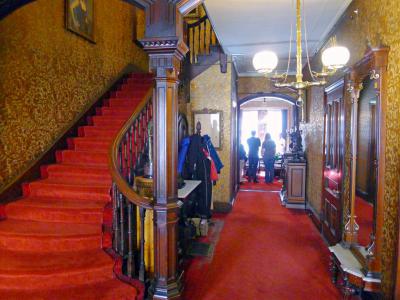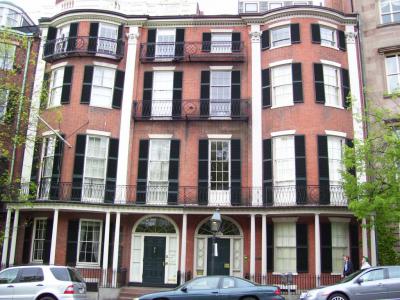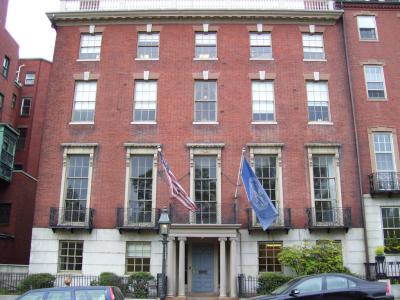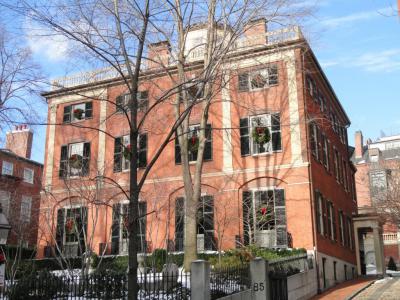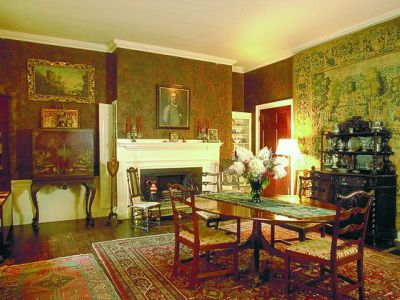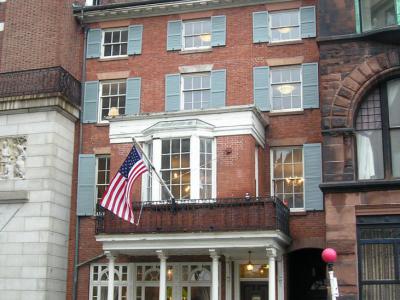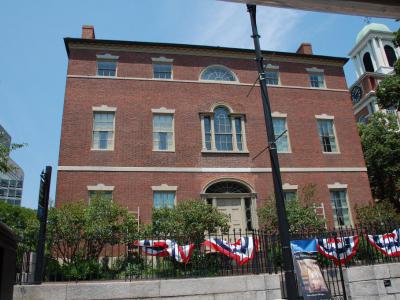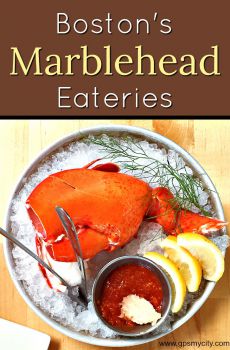Beacon Hill Historic Houses Tour (Self Guided), Boston
Boston’s historic neighborhood of Beacon Hill is quite a charm! One can spend hours here, admiring the elegant uniformity and restraint of the architecture; at times, perhaps, imagining people from the past in their horse-drawn carriages. Federal-style and Victorian row houses, narrow streets lit by antique gas lanterns, brick sidewalks and lavender-hued windows adorn the area, which is generally regarded as one of the most desirable and expensive in the city.
For a quick – but very engaging – tour of the historic buildings, start at the Gibson House Museum, where you’ll learn a great deal about Back Bay history and living in the Victorian times in general. Another highlight is the Nichols House Museum on Mount Vernon, which has likewise been preserved as it was left by its last occupant, Rose Nichols, and as such gives a great insight into the lives of Boston’s middle-class professional families of the late 19th and early 20th centuries.
Last but not least, don’t miss the several houses formerly owned by noted lawyer-politician Harrison Gray Otis, the first of which – a National Historic Landmark – is usually open to the public. You can get close to the furniture, walk around the rooms, and really internalize the grandeur!
Make sure to bring your walking shoes and to select a nice day for wandering around. Our self-guided walking tour will do the rest, acquainting you with some of Beacon Hill’s most exclusive addresses.
For a quick – but very engaging – tour of the historic buildings, start at the Gibson House Museum, where you’ll learn a great deal about Back Bay history and living in the Victorian times in general. Another highlight is the Nichols House Museum on Mount Vernon, which has likewise been preserved as it was left by its last occupant, Rose Nichols, and as such gives a great insight into the lives of Boston’s middle-class professional families of the late 19th and early 20th centuries.
Last but not least, don’t miss the several houses formerly owned by noted lawyer-politician Harrison Gray Otis, the first of which – a National Historic Landmark – is usually open to the public. You can get close to the furniture, walk around the rooms, and really internalize the grandeur!
Make sure to bring your walking shoes and to select a nice day for wandering around. Our self-guided walking tour will do the rest, acquainting you with some of Beacon Hill’s most exclusive addresses.
How it works: Download the app "GPSmyCity: Walks in 1K+ Cities" from Apple App Store or Google Play Store to your mobile phone or tablet. The app turns your mobile device into a personal tour guide and its built-in GPS navigation functions guide you from one tour stop to next. The app works offline, so no data plan is needed when traveling abroad.
Beacon Hill Historic Houses Tour Map
Guide Name: Beacon Hill Historic Houses Tour
Guide Location: USA » Boston (See other walking tours in Boston)
Guide Type: Self-guided Walking Tour (Sightseeing)
# of Attractions: 7
Tour Duration: 1 Hour(s)
Travel Distance: 2.1 Km or 1.3 Miles
Author: anna
Sight(s) Featured in This Guide:
Guide Location: USA » Boston (See other walking tours in Boston)
Guide Type: Self-guided Walking Tour (Sightseeing)
# of Attractions: 7
Tour Duration: 1 Hour(s)
Travel Distance: 2.1 Km or 1.3 Miles
Author: anna
Sight(s) Featured in This Guide:
- Gibson House Museum
- William Hickling Prescott House
- Otis House III
- Otis House II
- Nichols House Museum
- Chester Harding House
- Otis House I
1) Gibson House Museum
One of the pioneering residences in Back Bay, this house was crafted in the fashionable Italian Renaissance Revival style during the late 19th century, commissioned by Catherine Hammond Gibson, a remarkable woman of her time, who defied the odds as one of the few female property owners in the area. Fast forward to her grandson, Charles Hammond Gibson, Jr., a man of many talents – poet, horticulturalist, and travel enthusiast – who had a passion for preserving family history and decided to give this house a new lease on life as a museum after he passed away in 1954.
Back in its heyday, the Gibson House was quite the avant-garde residence. Although it might seem quaint compared to the mega-mansions that came later, it had all the bells and whistles of its time – gas lighting, basement-level indoor plumbing, and a state-of-the-art coal-fired central heating system. The interior is a real blast from the past, with goodies like a 1795 Willard clock, some ornate raised and gilded wallpaper, and a multifaceted faux-bamboo bedroom set. Unlike many of its Back Bay counterparts, the Gibson family's home has stood the test of time, with its Victorian fixtures and furniture preserved impeccably.
The house doubles as the go-to gathering spot for the New England chapter of the Victorian Society in America, and you might even recognize it as an interior setting from the 1984 Merchant Ivory film 'The Bostonians.'
Why You Should Visit:
If you're even remotely interested in history, this is a prime spot to immerse yourself in the upper-crust lifestyle of late 19th to mid-20th-century Beantown. Aside from being an observer, you can get the most out of the guided tour if you ask questions (so... don't be shy!).
Tip:
There are various types of tours available; general ones delve into the lives of the Gibson family and their domestic staff, while a monthly specialty tour called "Charlie Gibson’s Queer Boston" explores the early 20th-century gay subculture in Boston. They prefer not to interrupt ongoing tours, so be punctual. Also, keep an eye on their website for special events held throughout the year!
Guided Tours:
Thu: 3pm, 4pm, 5pm; Fri-Sun: 1pm, 2pm, 3pm
Back in its heyday, the Gibson House was quite the avant-garde residence. Although it might seem quaint compared to the mega-mansions that came later, it had all the bells and whistles of its time – gas lighting, basement-level indoor plumbing, and a state-of-the-art coal-fired central heating system. The interior is a real blast from the past, with goodies like a 1795 Willard clock, some ornate raised and gilded wallpaper, and a multifaceted faux-bamboo bedroom set. Unlike many of its Back Bay counterparts, the Gibson family's home has stood the test of time, with its Victorian fixtures and furniture preserved impeccably.
The house doubles as the go-to gathering spot for the New England chapter of the Victorian Society in America, and you might even recognize it as an interior setting from the 1984 Merchant Ivory film 'The Bostonians.'
Why You Should Visit:
If you're even remotely interested in history, this is a prime spot to immerse yourself in the upper-crust lifestyle of late 19th to mid-20th-century Beantown. Aside from being an observer, you can get the most out of the guided tour if you ask questions (so... don't be shy!).
Tip:
There are various types of tours available; general ones delve into the lives of the Gibson family and their domestic staff, while a monthly specialty tour called "Charlie Gibson’s Queer Boston" explores the early 20th-century gay subculture in Boston. They prefer not to interrupt ongoing tours, so be punctual. Also, keep an eye on their website for special events held throughout the year!
Guided Tours:
Thu: 3pm, 4pm, 5pm; Fri-Sun: 1pm, 2pm, 3pm
2) William Hickling Prescott House
Presenting a charming house museum today, this Federal-style gem, born in 1808 and designed by Asher Benjamin, was quite the rage during the Early Republic days. Originally, these twin townhouses were standalone structures with a serene water view, before the land now occupied by the Boston Public Garden was filled in. From 1845 to 1859, they were the dwelling of esteemed historian William Hickling Prescott (who made a name for himself with tomes on Spanish and Spanish colonial history) and his family. Since 1944, it's been the home base for the National Society of the Colonial Dames of America, and they've played a significant role in revitalizing the interior.
On guided tours, you'll amble through rooms decked out in period furnishings, including a glimpse into Prescott's former study, complete with his trusty desk and "noctograph", a nifty invention that aided the nearly blind scholar in his writing endeavors. Prescott even had a secret staircase up his sleeve, allowing him to make a crafty escape into his study whenever he grew weary of parlor guests.
Hung on a wall, amid the charming mix of Federalist and Victorian furniture, is a photograph of two crossed swords, once wielded by Colonel William Prescott and British Captain John Linzee – the grandfathers of our historian and his wife, respectively. These gentlemen crossed blades at Bunker Hill, and the display of their weapons here stirred the literary musings of William Thackeray, a frequent guest at the house, who penned his novel 'The Virginians' inspired by this very sight.
Tours are on the menu from April to October, so be sure to book your visit online!
On guided tours, you'll amble through rooms decked out in period furnishings, including a glimpse into Prescott's former study, complete with his trusty desk and "noctograph", a nifty invention that aided the nearly blind scholar in his writing endeavors. Prescott even had a secret staircase up his sleeve, allowing him to make a crafty escape into his study whenever he grew weary of parlor guests.
Hung on a wall, amid the charming mix of Federalist and Victorian furniture, is a photograph of two crossed swords, once wielded by Colonel William Prescott and British Captain John Linzee – the grandfathers of our historian and his wife, respectively. These gentlemen crossed blades at Bunker Hill, and the display of their weapons here stirred the literary musings of William Thackeray, a frequent guest at the house, who penned his novel 'The Virginians' inspired by this very sight.
Tours are on the menu from April to October, so be sure to book your visit online!
3) Otis House III
Charles Bulfinch (1763–1844), widely regarded as America's preeminent architect in the late 18th and early 19th centuries, forged a distinctive architectural style, straddling the line between Federal and Classical influences, that remains one of Boston's most iconic architectural signatures. Fusing his Neoclassical training with New England pragmatism, Bulfinch constructed residences known for their straight-edged brick exteriors and columned porticoes. Such examples abound in Beacon Hill, with notable instances at 87 Mount Vernon Street and 45 Beacon Street. The latter, completed in 1806, stands as the final and grandest of three edifices commissioned by Harrison Gray Otis, a lawyer who would go on to become Boston's mayor, and who resided here until his passing in 1848.
This four-story edifice is arranged into five bays, featuring a central entrance graced by a small, rectangular portico supported by delicate pairs of Ionic fluted columns. Originally, the unassuming ground floor displayed recessed brick arches characteristic of Bulfinch's house designs, though it now wears a stone facade. When initially constructed, the house stood independently, surrounded by the Boston Common and English Gardens. Since 1958, it has served as the headquarters of the American Meteorological Society.
This four-story edifice is arranged into five bays, featuring a central entrance graced by a small, rectangular portico supported by delicate pairs of Ionic fluted columns. Originally, the unassuming ground floor displayed recessed brick arches characteristic of Bulfinch's house designs, though it now wears a stone facade. When initially constructed, the house stood independently, surrounded by the Boston Common and English Gardens. Since 1958, it has served as the headquarters of the American Meteorological Society.
4) Otis House II
The second of three mansions designed for Harrison Gray Otis, it's the only one among the trio that's been continuously used as a private residence. Merely four years after constructing their first home, the Otis family decided to relocate to Beacon Hill, an area rapidly gaining prestige as an elegant place to reside. Otis was a member of the "Mount Vernon Proprietors", a consortium of real estate developers who owned the south slope of Beacon Hill, where the Massachusetts State House now stands. Together, they successfully transformed a once undeveloped pastureland into the most opulent residential enclave. As for the Otises, they once again turned to Bulfinch for the design.
Built between 1800 and 1802, this grand Federal-style structure rises three stories tall, featuring brick walls arranged in Flemish bond. It occupies a parcel of land with a relatively spacious lawn and a semicircular cobblestone driveway-a rare, surviving vestige of the original vision for Beacon Hill's development by the Mount Vernon Proprietors. Bulfinch's hallmark recessed brick arches grace the first floor of this house, embellished with ornate Chinese fretwork iron balconies. The facade comprises four bays, marked by the somewhat unusual use of Corinthian pilasters on the second and third floors. The Otis family resided here for only five years before enlisting Bulfinch once more to design their third and final residence.
Built between 1800 and 1802, this grand Federal-style structure rises three stories tall, featuring brick walls arranged in Flemish bond. It occupies a parcel of land with a relatively spacious lawn and a semicircular cobblestone driveway-a rare, surviving vestige of the original vision for Beacon Hill's development by the Mount Vernon Proprietors. Bulfinch's hallmark recessed brick arches grace the first floor of this house, embellished with ornate Chinese fretwork iron balconies. The facade comprises four bays, marked by the somewhat unusual use of Corinthian pilasters on the second and third floors. The Otis family resided here for only five years before enlisting Bulfinch once more to design their third and final residence.
5) Nichols House Museum
A stroll along Mount Vernon Street offers views of some of Beacon Hill's most splendid buildings. Dating back to 1804 and adorned with a Greek Revival portico in 1830, this house, designed by renowned Boston architect Charles Bulfinch, stands as a prime example of his domestic architecture and is the only Beacon Hill residence open to the public year-round.
Previously the residence of Rose Standish Nichols, affectionately known as Miss Rose, until 1960, this house not only boasts architectural beauty but also has a rich history. As a suffragette and advocate for peace, Miss Rose co-founded the Women's International League for Peace and Freedom and made the unconventional choice to prioritize a successful career in landscape gardening over marriage and family life, traveling extensively to document gardens worldwide.
During guided tours, you'll have the opportunity to view her precious heirlooms, including Federal-era furniture, exquisite Asian and Flemish tapestries, sculptures crafted by the renowned 19th-century American artist Augustus Saint-Gaudens, and remarkable examples of Miss Rose's own needlepoint and woodwork, thus gaining insight into the opulent lifestyle led by Beacon Hill's affluent elite.
Why You Should Visit:
Ideal opportunity to peek inside Beacon Hill's magnificent mansions. Highly recommended for anyone with an interest in Bostonian history, antiques, textiles, preservation, understanding family dynamics, or simply looking for a delightful way to pass the time (which, let's face it, includes just about everyone). You'll be guided by highly knowledgeable tour guides, and the crowds are usually sparse.
Guided Tours (lasting 30-45 minutes):
Wed-Sun: 10am, 11am, 12pm
Previously the residence of Rose Standish Nichols, affectionately known as Miss Rose, until 1960, this house not only boasts architectural beauty but also has a rich history. As a suffragette and advocate for peace, Miss Rose co-founded the Women's International League for Peace and Freedom and made the unconventional choice to prioritize a successful career in landscape gardening over marriage and family life, traveling extensively to document gardens worldwide.
During guided tours, you'll have the opportunity to view her precious heirlooms, including Federal-era furniture, exquisite Asian and Flemish tapestries, sculptures crafted by the renowned 19th-century American artist Augustus Saint-Gaudens, and remarkable examples of Miss Rose's own needlepoint and woodwork, thus gaining insight into the opulent lifestyle led by Beacon Hill's affluent elite.
Why You Should Visit:
Ideal opportunity to peek inside Beacon Hill's magnificent mansions. Highly recommended for anyone with an interest in Bostonian history, antiques, textiles, preservation, understanding family dynamics, or simply looking for a delightful way to pass the time (which, let's face it, includes just about everyone). You'll be guided by highly knowledgeable tour guides, and the crowds are usually sparse.
Guided Tours (lasting 30-45 minutes):
Wed-Sun: 10am, 11am, 12pm
6) Chester Harding House
Situated across from the Massachusetts State House on Beacon Hill, this four-story townhouse, constructed in the Federal architectural style, was originally built as a private residence by real estate developer Thomas Fletcher in 1808, during a time when Park Street and Beacon Street were lined with dilapidated public buildings.
Marked by a commemorative plaque on its left side, it gained recognition as a U.S. National Historic Landmark in 1965 and is celebrated for its connection to the renowned American portrait painter, Chester Harding, who purchased the house in 1826 and lived here until 1830. Although not as famous today as Gilbert Stuart, Harding enjoyed significant acclaim during his time, having completed over 1,000 portraits throughout his career. In fact, Stuart once lamented that "Harding Fever" had overshadowed his own work.
The house still serves as the headquarters of the Boston Bar Association, which acquired the building in 1962; their logo embellishes the front door. Two larger structures now flank the townhouse: the six-story Claflin Building, originally constructed as a commercial building in 1873 but later converted into luxury condominiums, and the eight-story Congregational House, erected in 1998.
.
Marked by a commemorative plaque on its left side, it gained recognition as a U.S. National Historic Landmark in 1965 and is celebrated for its connection to the renowned American portrait painter, Chester Harding, who purchased the house in 1826 and lived here until 1830. Although not as famous today as Gilbert Stuart, Harding enjoyed significant acclaim during his time, having completed over 1,000 portraits throughout his career. In fact, Stuart once lamented that "Harding Fever" had overshadowed his own work.
The house still serves as the headquarters of the Boston Bar Association, which acquired the building in 1962; their logo embellishes the front door. Two larger structures now flank the townhouse: the six-story Claflin Building, originally constructed as a commercial building in 1873 but later converted into luxury condominiums, and the eight-story Congregational House, erected in 1998.
.
7) Otis House I
Constructed in 1795-96, this house, adjacent to the Old West Church, was the first of three properties masterminded by the esteemed American architect, Charles Bulfinch. It was designed for Harrison Gray Otis, a prominent Massachusetts politician and Federalist lawyer, who, alongside his wife Sally, frequently hosted extravagant parties here. Notable for being among the earliest three-story brick houses that exemplified the Federal architectural style, its interior showcases the influence of Robert Adam.
Although the most unassuming of the three residences designed by Bulfinch for Otis, its inspiration is traced back to a William Bingham house in Philadelphia, which Bulfinch encountered in 1789 and was, in turn, derived from a London residence. Characterized by its three stories, five-bay width, and refined string courses, the structure has a graceful entrance added post-1801, adorned with a splendid Palladian window above it, capped by a lunette. The third floor is notably short, with ceilings just over six feet tall.
In 1916, the Historic New England society acquired the house for use as its headquarters. Originally positioned 40 feet forward from its current location, it was relocated in the 1920s to evade the widening of Cambridge Street, albeit losing its original cellar in the process. Today, connected to a row of houses on Lynde Street serving as offices for Historic New England, the house underwent meticulous restoration in 1960, focusing on the brilliantly colored wallpapers, carpeting, and high-style furnishings. It is open year-round for tours, offering insights into family life during the Federal era and the house's later history when it served as a medical facility providing "Champoo Baths" (a type of traditional aromatherapy treatment) before being transformed into a middle-class boarding facility.
Although the most unassuming of the three residences designed by Bulfinch for Otis, its inspiration is traced back to a William Bingham house in Philadelphia, which Bulfinch encountered in 1789 and was, in turn, derived from a London residence. Characterized by its three stories, five-bay width, and refined string courses, the structure has a graceful entrance added post-1801, adorned with a splendid Palladian window above it, capped by a lunette. The third floor is notably short, with ceilings just over six feet tall.
In 1916, the Historic New England society acquired the house for use as its headquarters. Originally positioned 40 feet forward from its current location, it was relocated in the 1920s to evade the widening of Cambridge Street, albeit losing its original cellar in the process. Today, connected to a row of houses on Lynde Street serving as offices for Historic New England, the house underwent meticulous restoration in 1960, focusing on the brilliantly colored wallpapers, carpeting, and high-style furnishings. It is open year-round for tours, offering insights into family life during the Federal era and the house's later history when it served as a medical facility providing "Champoo Baths" (a type of traditional aromatherapy treatment) before being transformed into a middle-class boarding facility.
Walking Tours in Boston, Massachusetts
Create Your Own Walk in Boston
Creating your own self-guided walk in Boston is easy and fun. Choose the city attractions that you want to see and a walk route map will be created just for you. You can even set your hotel as the start point of the walk.
Boston Shopping Areas
One of the top shopping destinations in the US northeast, Boston has a strong network of interesting stores, galleries and boutiques to visit along with its many high-class shops, some of which are nestled inside historical buildings. Shopping here in more than one way mirrors the city itself: an amalgamation of classic and vanguard, the handmade and the high-end, and both local and international... view more
Tour Duration: 2 Hour(s)
Travel Distance: 3.2 Km or 2 Miles
Tour Duration: 2 Hour(s)
Travel Distance: 3.2 Km or 2 Miles
Harvard University Walking Tour
The United States’ oldest institution of higher education (and, of course, among the most prestigious), Harvard was established in 1636. Reverend John Harvard, who bequeathed his entire library and half of his estate, is the University’s namesake. Presidents, billionaires and Rhodes Scholars are only some of the illustrious graduates; in fact, Harvard has more Nobel Prize-winning alumni,... view more
Tour Duration: 2 Hour(s)
Travel Distance: 2.3 Km or 1.4 Miles
Tour Duration: 2 Hour(s)
Travel Distance: 2.3 Km or 1.4 Miles
Historical Cambridge MA Walking Tour
Once a quiet New England farming village-turned capital of the Massachusetts Bay Colony, today's Cambridge, MA is a university town that dazzles visitors as the home of renowned Harvard University – alma mater of many intellectuals, literary geniuses, celebrities, and wealthy and powerful. Many of America’s elite have spent some time at Harvard, and their contributions to Cambridge have... view more
Tour Duration: 2 Hour(s)
Travel Distance: 3.5 Km or 2.2 Miles
Tour Duration: 2 Hour(s)
Travel Distance: 3.5 Km or 2.2 Miles
North End Walking Tour
The North End was the city's first neighborhood, and one that has been key to its fortunes, having become a hub of commercial, social and intellectual activity by the 1750s. Later known as Boston's Little Italy, it has been home to Italian immigrants through much of the 20th century, and still retains a certain Mediterranean flavor in its many restaurants, cafés, and specialty shops. In... view more
Tour Duration: 1 Hour(s)
Travel Distance: 1.0 Km or 0.6 Miles
Tour Duration: 1 Hour(s)
Travel Distance: 1.0 Km or 0.6 Miles
North End Food Tour
Boston’s North End is famous primarily for its Italian food. By far not as big as New York's Little Italy, this one-square-mile waterfront community is the oldest in the city, and is packed to the brim with a cornucopia of Italian eateries – restaurants, cafes, espresso bars, pizza and sandwich shops – lined next to each other within just a few short blocks to ensure visitors both a... view more
Tour Duration: 1 Hour(s)
Travel Distance: 0.8 Km or 0.5 Miles
Tour Duration: 1 Hour(s)
Travel Distance: 0.8 Km or 0.5 Miles
Bunker Hill Walking Tour
Bunker Hill, sitting on the bank of the Charles River in Boston, Massachusetts, is a historic site that holds great significance in American history. At its heart stands the Bunker Hill Monument, a towering obelisk commemorating the Battle of Bunker Hill, a pivotal event in the American Revolutionary War.
The battle took place on June 17, 1775, when American patriots faced off against British... view more
Tour Duration: 1 Hour(s)
Travel Distance: 1.5 Km or 0.9 Miles
The battle took place on June 17, 1775, when American patriots faced off against British... view more
Tour Duration: 1 Hour(s)
Travel Distance: 1.5 Km or 0.9 Miles
Useful Travel Guides for Planning Your Trip
Boston's Marblehead Eateries
With such a diverse variety of dining cuisines and styles, the little town of Marblehead has something to satisfy every budget and culinary palate. You won't find any neon here, none is allowed in town and there are no fast food or drive-thrus establishments either. Most are quaint and...
The Most Popular Cities
/ view all



